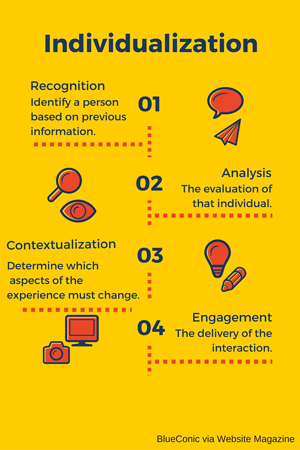Flip the Script: Individualizing Experiences in 2016

:: By Cory Munchbach, BlueConic ::
The need to master personalization - or individualization - has drastically risen recently, driven by increased consumer expectations and a greater proximity to finding easy solutions to meet consumers' needs.
The number of ways that brands can connect with consumers is unprecedented and yet, as a consequence, there is more competition. Companies now deal constantly with having to find new ways to differentiate in the market, turning the dials on product, messaging, service, offers and any other aspects they can think of. For marketing and sales in particular, data-driven tailoring of experiences can drive an ROI of 15-20 percent or more according to McKinsey.
Customer experience as a business priority has exploded over the last five or so years and unsurprisingly: brands and analyst firms have demonstrated time and again the correlation between superior customer experience and higher revenue growth. For marketers, this has brought perhaps unwelcomed attention to the tactics that have constituted traditional marketing - batch-and-blast, one-size-fits-all outbound messaging across any and all places a customer might be - which are not exactly customer-first approaches to engagement.
Now is the time to flip the script.
Individualization is "the ability to recognize an individual, establish their intent and create a uniquely constructed, in-context interaction that facilitates progress along that person's customer journey." Marketers are constantly trying to deliver this type of individualized experience - but often struggle with it in practice. When it comes to data, according to eMarketers, only 31 percent of marketers say they have an average or strong capability for integrating user data from different systems into one profile store. Only eight percent say they use psychographics for personalization while the far and away leader, email address, is still only used by 57 percent of marketers. In other words, as a brand's voice, marketers are barely scraping the surface of what it would mean to carry on continuous and contextual conversation with our customers.
There are four critical capabilities that, when mastered and deployed together, make up true individualization. They are:
 Recognition
Recognition
The identification of an individual and an association of that person with any existing information about them from previous interactions and other systems, whether they are specifically identifiable or in an anonymous state. Example: a visitor to your site gets a tailored retargeted ad and then returns to the site and is recognized as the same unique person.
Analysis
The evaluation of that individual, based on all known and inferred insights, current actions and historical data, to determine their intent. Example: Web analytics and email campaign data are unified to assess what constitutes the user's decision journey.
Contextualization
The determination of which aspects of the experience must be changed, either in real-time or as a predictive decision to best suit the individual's needs, including content, functionality and presentation. Example: data about a shopper in the customer relationship management (CRM) system is enriched with interest data from the data management platform (DMP) and used together in a tailored message.
Engagement
The delivery of the interaction to the user at the appropriate time (immediately or in the future) and in the right channel (current or future). Example: a customer event that takes place in CRM triggers a new experience in the mobile app.
To do any of these with success - never mind fully mastering individualization - requires a strategic approach to customer data management. Better customer data management can give marketers the knowledge they need about individual consumers to drive better business outcomes. In fact, according to a recent study, 84 percent of marketers say they have "weak" or "no" capability when it comes to distributing profile store data to different marketing technology vendors. This is because individualization requires that marketers not adhere to a vastly generalized set of steps that constitute the purchase path, but rather fully embrace customer life cycle.
Life cycle exercises are incredibly useful for organizing clusters of information and content that closes the gap between mass marketing and engaging with a single person. Sitting down with other marketing leaders and unifying all the different versions (or creating one from scratch if it hasn't been done yet), provides a common starting point for organizing identifiers, content, etc., around the three phases of the life cycle - acquire, engage and retain.
Below are a few examples of industries that are using innovative approaches to customer data management at each life cycle phase, in order to promote a visitor's continued journey.
In the acquisition phase, its important to use first-party data - from activity on your owned properties, historical CRM insight, or social identities - to create rich segments that can be used as the basis for look-alike modeling within acquisition campaigns. Or, match interests with messages like a U.S.-based insurer does, by taking individual customer data in real-time from Web behavior, creating segments and then delivering dynamically created ads based on that segmentation.
Studies show that the more time an individual spends engaging on a brand's site, the more likely they are to convert and perform meaningful actions, but typically companies struggle to create personalized experiences at scale that lead to meaningful outcomes. For example, publishers can be radically better at suggesting contextually relevant content when it isn't solely based on what other people are reading, but rather based on what time of day a person is reading, what they've read in the past and what they're browsing at that instant. Or a retailer can dynamically adjust offers based on a shopper's priorities, be they shipping (because they read the shipping terms) or discounts (because they went straight to the sale section).
Leading companies are embracing a more holistic approach that ensures any communication - regardless of who within the company "owns" that interaction - is fully up-to-date with data from all other touchpoints, particularly the digital ones, along an individual's decision path. This ultimately leads to far more relevant and personalized conversations - regardless of the channel. Follow the lead here of a North American asset management company that, based on the funds a financial advisor has expressed interest in, makes sure the advisor knows when new commentaries are available without having to sign up for any kind of notification or put in a request.
The one thing that should be top of mind for organizations is the need for marketers to go beyond personalization to develop meaningful interactions that will result in business outcomes for their brand.
Cory Munchbach is the VP of marketing at BlueConic and a former Forrester Analyst.
Subscribe to Our Newsletter!
Latest in Software








